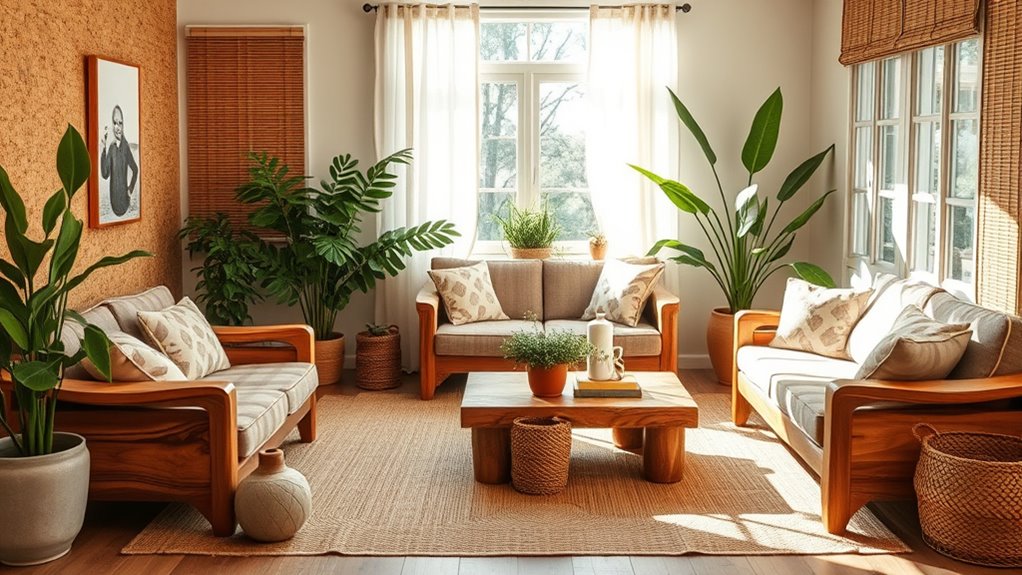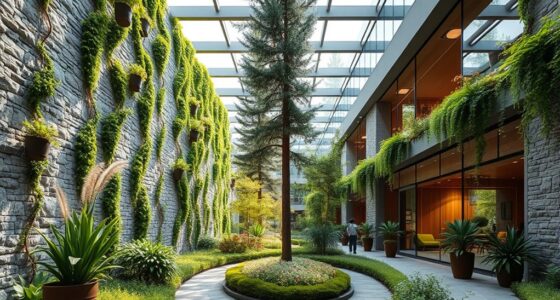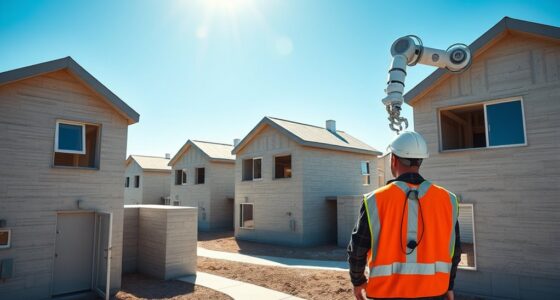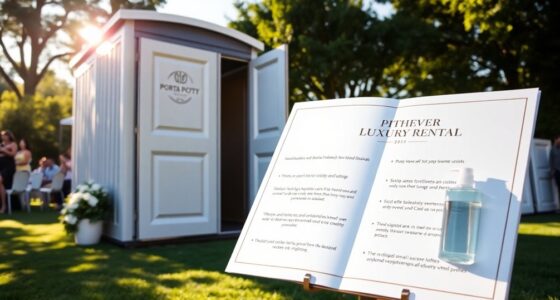To embrace eco-friendly interior design, focus on using sustainable furniture and decor like upcycled pieces, reclaimed wood, and recycled metals. Opt for natural color palettes such as earth tones to create a calming environment. Support brands that prioritize ethically sourced and low-impact materials. Incorporate eco-friendly elements like solar lighting and self-watering plants. By making intentional choices, you’ll craft a stylish space that reflects your commitment to sustainability—discover how all these elements come together as you continue exploring.
Key Takeaways
- Incorporate upcycled furniture and decor items that add character while reducing waste.
- Choose eco-friendly materials like reclaimed wood, recycled metal, and biodegradable textiles.
- Use a natural color palette with earth tones to promote harmony and sustainability.
- Opt for sustainable brands with certifications such as FSC or GREENGUARD for responsible sourcing.
- Integrate eco-conscious features like solar lighting and low-VOC paints to enhance energy efficiency.
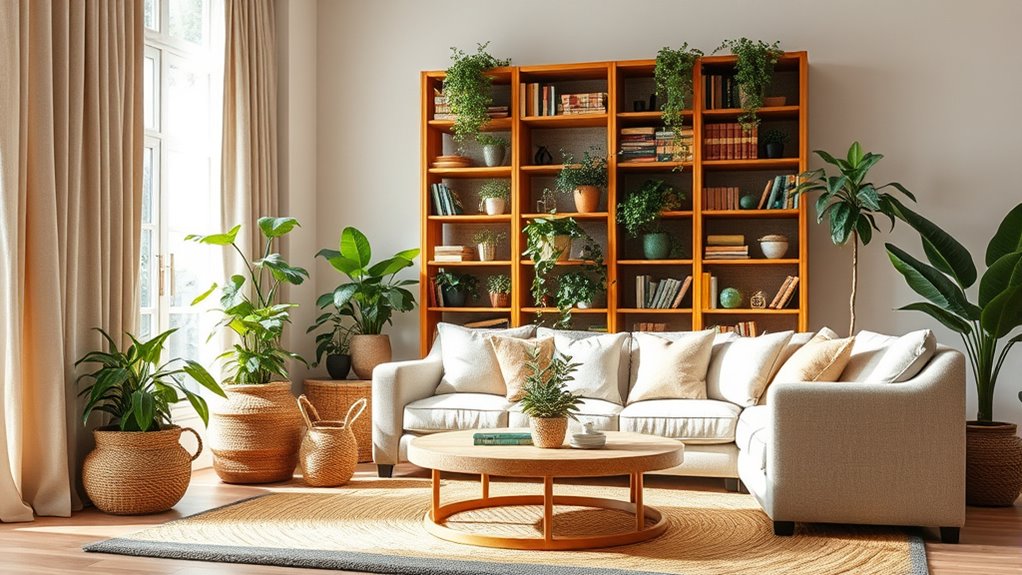
As more people seek eco-friendly living spaces, sustainable furniture and decor have become essential components of modern interior design. You’re likely looking for ways to reduce your environmental impact while creating a stylish, inviting home. One effective approach is to incorporate upcycling materials into your decor. Instead of discarding old furniture or unused items, you can transform them into unique, functional pieces that add character and charm. For example, repurposing wooden pallets into coffee tables or turning vintage suitcases into side tables not only minimizes waste but also gives your space a personal touch. These upcycled items often carry stories and textures that mass-produced furniture simply can’t match, making your home feel both eco-conscious and authentic.
Transform old furniture into charming, eco-friendly pieces that add character and reduce waste.
In addition to upcycling, choosing an eco conscious color palette can markedly enhance your sustainable design efforts. Earth tones like warm browns, muted greens, soft beiges, and calming blues evoke a sense of harmony with nature. These colors not only create a tranquil environment but also align with eco-friendly principles by reducing the need for synthetic dyes or chemical treatments often found in conventional paints. When selecting paints or textiles, opt for those labeled low-VOC or natural, further supporting your commitment to sustainability. By sticking to eco conscious color palettes, you craft a cohesive aesthetic that feels both modern and environmentally responsible, making it easier to curate a space that reflects your values.
You’ll find that integrating sustainable furniture and decor isn’t just about the materials you choose—it’s about making intentional decisions. For instance, when shopping for new pieces, prioritize brands that prioritize ethically sourced, eco-friendly materials or certifications like FSC or GREENGUARD. When decorating, look for items made from reclaimed wood, recycled metal, or biodegradable textiles. These choices not only reduce your carbon footprint but also inspire others to think about the lifecycle of their possessions. Plus, mixing upcycled pieces with new eco-friendly items gives your home a layered, curated look that’s uniquely yours. Incorporating sustainable energy solutions like solar-powered lighting can further enhance your eco-friendly interior design by reducing reliance on non-renewable energy sources. It’s also helpful to be aware of local store hours when shopping in person for these items, as knowing your local Ulta Beauty Store Hours, for example, can help you plan your visits efficiently. Ultimately, sustainable interior design is about aligning your aesthetic preferences with your environmental values. By thoughtfully incorporating upcycling materials and selecting an eco conscious color palette, you create a space that’s beautiful, functional, and kind to the planet. Exploring self watering plant pots can be an excellent way to add low-maintenance greenery that supports sustainable living practices. It’s a rewarding process that encourages creativity and mindful consumption, helping you build a home that truly reflects your commitment to a greener future.
Frequently Asked Questions
How Can I Verify the Sustainability Claims of Furniture Brands?
To verify sustainability claims of furniture brands, start by checking their certification standards like FSC or GREENGUARD. These certifications guarantee eco-friendly practices. Also, look for brand transparency—see if they openly share sourcing, manufacturing processes, and environmental impact info. Doing research on their policies and reading customer reviews can give you confidence that their sustainability claims are genuine, helping you make eco-conscious choices confidently.
What Eco-Friendly Materials Are Best for Small Spaces?
Imagine transforming your small space into a green haven. You can choose eco-friendly materials like bamboo flooring, which is rapid-growing and sustainable. Recycled plastics make great furniture pieces, reducing waste and adding unique touches. These materials save space without sacrificing style or sustainability. By opting for bamboo and recycled plastics, you create a healthier environment and a beautiful, eco-conscious home that reflects your values.
Are There Cost-Effective Options for Sustainable Decor?
You’re wondering if there are budget-friendly options for sustainable decor. Absolutely! You can explore DIY sustainable decor projects to save money while making eco-conscious choices. Look for affordable, recycled, or upcycled materials and get creative with your designs. Many online tutorials provide easy, cost-effective ideas. By doing so, you not only stay within your budget but also contribute to a greener environment, making your space both stylish and sustainable.
How Does Eco-Friendly Interior Design Impact Indoor Air Quality?
You might wonder how eco-friendly interior design impacts indoor air quality. By choosing sustainable furniture and decor, you help reduce indoor air pollution caused by harmful chemicals and volatile organic compounds (VOCs). This also promotes allergen reduction, making your space healthier. As a result, your indoor environment becomes safer and more comfortable, benefiting your overall well-being and creating a more sustainable home.
Can Sustainable Furniture Be as Durable as Conventional Options?
You might wonder if sustainable furniture can match conventional options in durability. Generally, durability comparisons show that high-quality sustainable furniture, made with durable materials like reclaimed wood or bamboo, offers excellent material longevity. While some eco-friendly choices might have shorter lifespans, many modern sustainable designs are built to last, proving that eco-conscious options can be as durable as traditional furniture when you select wisely and prioritize craftsmanship.
Conclusion
By choosing eco-friendly furniture and decor, you become a gardener of the Earth, nurturing beauty and sustainability in every space. Your home transforms into a vibrant oasis where nature and design dance in harmony. Each mindful choice plants seeds of change, creating a legacy of green living. Embrace these sustainable treasures, and watch your space bloom with eco-conscious charm—turning your home into a sanctuary that celebrates both style and Mother Earth’s gentle embrace.
